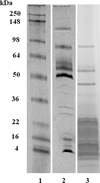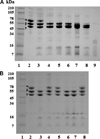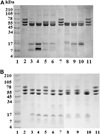Hemostatic and toxinological diversities in venom of Micrurus tener tener, Micrurus fulvius fulvius and Micrurus isozonus coral snakes
- PMID: 21596052
- PMCID: PMC3304457
- DOI: 10.1016/j.toxicon.2011.04.020
Hemostatic and toxinological diversities in venom of Micrurus tener tener, Micrurus fulvius fulvius and Micrurus isozonus coral snakes
Abstract
The coral snake Micrurus tener tener (Mtt) from the Elapidae family inhabits the southwestern United States and produces severe cases of envenomations. Although the majority of Mtt venom components are neurotoxins and phospholipase A₂s, this study demonstrated, by SDS-PAGE and molecular exclusion chromatography (MEC), that these venoms also contain high-molecular-weight proteins between 50 and 150 kDa that target the hemostatic system. The biological aspects of other Micrurus venoms were also studied, such as the LD₅₀s of Micrurus isozonus (from 0.52 to 0.61 mg/kg). A pool from these venoms presented a LD₅₀ of 0.57 mg/kg, Micrurus f. fulvius (Mff) and Mtt had LD₅₀s of 0.32 and 0.78 mg/kg, respectively. These venoms contained fibrino(geno)lytic activity, they inhibited platelet aggregation, as well as factor Xa and/or plasmin-like activities. M. isozonus venoms from different Venezuelan geographical regions inhibited ADP-induced platelet aggregation (from 50 to 68%). Micrurus tener tener venom from the United States was the most active with a 95.2% inhibitory effect. This venom showed thrombin-like activity on fibrinogen and human plasma. Fractions of Mtt showed fibrino(geno)lytic activity and inhibition on plasmin amidolytic activity. Several fractions degraded the fibrinogen Aα chains, and fractions F2 and F7 completely degraded both fibrinogen Aα and Bβ chains. To our knowledge, this is the first report on thrombin-like and fibrino(geno)lytic activity and plasmin or factor Xa inhibitors described in Micrurus venoms. Further purification and characterization of these Micrurus venom components could be of therapeutic use in the treatment of hemostatic disorders.
Copyright © 2011 Elsevier Ltd. All rights reserved.
Conflict of interest statement
The authors declare no conflicts of interest.
Figures






Similar articles
-
Purification and characterization of tenerplasminin-1, a serine peptidase inhibitor with antiplasmin activity from the coral snake (Micrurus tener tener) venom.Comp Biochem Physiol C Toxicol Pharmacol. 2016 Jan;179:107-15. doi: 10.1016/j.cbpc.2015.09.009. Epub 2015 Sep 28. Comp Biochem Physiol C Toxicol Pharmacol. 2016. PMID: 26419785 Free PMC article.
-
Neutralization of two North American coral snake venoms with United States and Mexican antivenoms.Toxicon. 2008 Feb;51(2):297-303. doi: 10.1016/j.toxicon.2007.10.004. Epub 2007 Oct 13. Toxicon. 2008. PMID: 18054059 Free PMC article.
-
Australian tiger snake (Notechis scutatus) and mexican coral snake (Micruris species) antivenoms prevent death from United States coral snake (Micrurus fulvius fulvius) venom in a mouse model.J Toxicol Clin Toxicol. 2003;41(1):7-10. doi: 10.1081/clt-120018264. J Toxicol Clin Toxicol. 2003. PMID: 12645961
-
Venoms of Micrurus coral snakes: Evolutionary trends in compositional patterns emerging from proteomic analyses.Toxicon. 2016 Nov;122:7-25. doi: 10.1016/j.toxicon.2016.09.008. Epub 2016 Sep 15. Toxicon. 2016. PMID: 27641749 Review.
-
Coral snake bites (Micrurus spp.) in Brazil: a review of literature reports.Clin Toxicol (Phila). 2016 Mar;54(3):222-34. doi: 10.3109/15563650.2015.1135337. Epub 2016 Jan 25. Clin Toxicol (Phila). 2016. PMID: 26808120 Review.
Cited by
-
Effects of Mlx-8, a phospholipase A2 from Brazilian coralsnake Micrurus lemniscatus venom, on muscarinic acetylcholine receptors in rat hippocampus.J Venom Anim Toxins Incl Trop Dis. 2020 Jan 27;26:e20190041. doi: 10.1590/1678-9199-JVATITD-2019-0041. eCollection 2020. J Venom Anim Toxins Incl Trop Dis. 2020. PMID: 32063920 Free PMC article.
-
Preliminary assessment of Hedychium coronarium essential oil on fibrinogenolytic and coagulant activity induced by Bothrops and Lachesis snake venoms.J Venom Anim Toxins Incl Trop Dis. 2014 Sep 1;20:39. doi: 10.1186/1678-9199-20-39. eCollection 2014. J Venom Anim Toxins Incl Trop Dis. 2014. PMID: 26413083 Free PMC article.
-
Purification and characterization of tenerplasminin-1, a serine peptidase inhibitor with antiplasmin activity from the coral snake (Micrurus tener tener) venom.Comp Biochem Physiol C Toxicol Pharmacol. 2016 Jan;179:107-15. doi: 10.1016/j.cbpc.2015.09.009. Epub 2015 Sep 28. Comp Biochem Physiol C Toxicol Pharmacol. 2016. PMID: 26419785 Free PMC article.
-
Functional characterizations of venom phenotypes in the eastern diamondback rattlesnake (Crotalus adamanteus) and evidence for expression-driven divergence in toxic activities among populations.Toxicon. 2016 Sep 1;119:28-38. doi: 10.1016/j.toxicon.2016.05.005. Epub 2016 May 11. Toxicon. 2016. PMID: 27179420 Free PMC article.
-
Coralsnake Venomics: Analyses of Venom Gland Transcriptomes and Proteomes of Six Brazilian Taxa.Toxins (Basel). 2017 Jun 8;9(6):187. doi: 10.3390/toxins9060187. Toxins (Basel). 2017. PMID: 28594382 Free PMC article.
References
-
- Aguilar I, Girón ME, Rodríguez-Acosta A. Purification and characterization of a hemorrhagic fraction from the venom of the Uracoan rattlesnake Crotalus vegrandis. Biochim. Byophys. Acta. 2001;1548:57–65. - PubMed
-
- Aird SD, da Silva NJ., Jr Comparative enzymatic composition of Brazilian coral snake (Micrurus) venoms. Comp. Biochem. Physiol. B. 1991;99:287–294. - PubMed
-
- Alape-Girón A, Lomonte B, Gustafsson B, Da Silva NJ, Thelestam M. Electrophoretic and immunochemical studies of Micrurus snake venoms. Toxicon. 1994;32:713–723. - PubMed
-
- Alape-Girón A, Persson B, Cederlund E, Flores-Díaz M, Gutiérrez JM, Thelestam M, Bergman T, Jörnvall H. Elapid venom toxins: multiple recruitments of ancient scaffolds. Eur. J. Biochem. 1999:225–234. - PubMed
-
- Arce V, Rojas E, Ownby CL, Rojas G, Gutiérrez JM. Preclinical assessment of the ability of polyvalent (Crotalinae) and anticoral (Elapidae) antivenoms produced in Costa Rica to neutralize the venoms of North American snakes. Toxicon. 2003;41:851–860. - PubMed
Publication types
MeSH terms
Substances
Grants and funding
LinkOut - more resources
Full Text Sources
Miscellaneous

